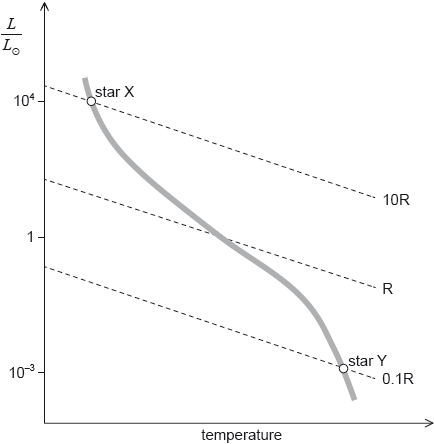| Date | November 2020 | Marks available | 2 | Reference code | 20N.3.HL.TZ0.22 |
| Level | Higher level | Paper | Paper 3 | Time zone | 0 - no time zone |
| Command term | Show | Question number | 22 | Adapted from | N/A |
Question
The data for the star Eta Aquilae A are given in the table.
is the luminosity of the Sun and is the mass of the Sun.
Show by calculation that Eta Aquilae A is not on the main sequence.
Estimate, in , the distance to Eta Aquilae A using the parallax angle in the table.
Estimate, in , the distance to Eta Aquilae A using the luminosity in the table, given that .
Suggest why your answers to (b)(i) and (b)(ii) are different.
Eta Aquilae A is a Cepheid variable. Explain why the brightness of Eta Aquilae A varies.
Eta Aquilae A was on the main sequence before it became a variable star. Compare, without calculation, the time Eta Aquilae A spent on the main sequence to the total time the Sun is likely to spend on the main sequence.
Markscheme
✓
the luminosity of Eta (2630) is very different «so it is not main sequence» ✓
Allow calculation of to give so not main sequence
OWTTE
✓
Use of ✓
✓
✓
Award [3] marks for a bald correct answer between and
parallax angle in milliarc seconds/very small/at the limits of measurement ✓
uncertainties/error in measuring οr or ✓
values same order of magnitude, so not significantly different ✓
Accept answers where MP1 and MP2 both refer to parallax angle
OWTTE
reference to change in size ✓
reference to change in temperature ✓
reference to periodicity of the process ✓
reference to transparency / opaqueness ✓
shorter time ✓
star more massive and mass related to luminosity
OR
star more massive and mass related to time in main sequence
OR
position on HR diagram to the left and above shows that will reach red giant region sooner ✓
Examiners report
Most candidates were successful in using the mass luminosity relationship.
The conversion to parsecs proved to be a very well known skill.
Very well answered by most candidates.
Candidates related the difference in the two methods for finding d to the large uncertainty in finding parallax angle at this distance (>400pc). Fewer also spotted that the luminosity of the star is also error prone unless its distance is already known.
Candidates were clearly familiar with Cepheids and the process leading to its variability in brightness.
Candidates showed clear ideas and were able to explain successfully why Eta Aquilae A lifetime as a main sequence star is much shorter than the one expected for the Sun.


